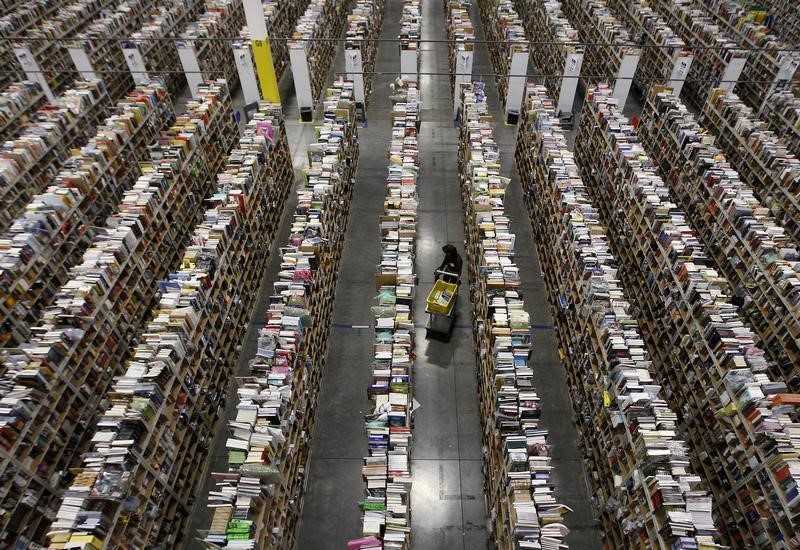By Deepa Seetharaman and Nathan Layne
SAN FRANCISCO/CHICAGO (Reuters) - For top U.S. retailers, free delivery is now the norm. That is good news for shoppers, but not so much for investors.
During the just-ended holiday season, outlets from Target to Wal-Mart to Amazon expanded their free-delivery options, adding more items eligible for free shipping. They also did away with minimum spending thresholds to qualify for the perk.
Yet as more U.S. shoppers view free shipping as their right, retailers struggle to make a profit online. That struggle will become evident in coming weeks when companies report financial results for the holiday quarter, analysts said.
"For most companies, it is a very expensive proposition to try to offer fast and free," Steve Osburn, director of supply chain for consulting firm Kurt Salmon, said in an interview. "It's really eating away at the margin dollars at some of these retailers."
Shipping remains a key battleground in the escalating war between brick-and-mortar retailers and Amazon.com Inc, with both sides spending big on logistics. Offering free shipping has long been standard practice during the holidays, but in 2014, retailers leaned on it heavily all year long.
The number of online purchases in the United States with free delivery hit a high of 68 percent in the third quarter of 2014, according to industry-data tracker comScore, up from 44 percent the previous year. Amazon said this week that it saved customers $2 billion (1.29 billion pounds) in shipping fees over the holidays.
Much of those savings came via Amazon's Prime programme, which offers free shipping on most items for a $99 annual fee.
The company declined to share the previous year's figure. Nor would it share estimates on how much more Prime customers bought compared with others, which would provide some insight into how much Prime might boost Amazon's revenue. Forrester Research analyst Sucharita Mulpuru estimates that Amazon loses $1 billion to $2 billion a year on U.S. Prime shipments.
Other retailers, including Target Corp and Wal-Mart Stores Inc, are removing minimum-spending thresholds on free shipping to entice consumers, consultants said. Just over half of companies surveyed by Kurt Salmon eliminated those thresholds for the 2014 holiday season, up from 5 percent the previous year.
PERKS AT A PRICE
But those perks come at a high price, analysts said. Amazon's shipping costs during the first nine months of 2014 rose 32 percent, compared with 29 percent in the same period of 2013.
This growing subsidy for customers might give investors more reason to dump Amazon shares. The company's stock declined 22 percent in 2014 even as the U.S. stock market, as measured by the S&P 500 index, gained more than 11 percent.
Target said in November that growing online sales were pressuring margins, due in large part to higher shipping expenses. Much like Amazon, Target offers free shipping year-round for users of its membership card. Online orders account for about 2.5 percent of Target's overall revenue, or roughly $1.85 billion out of the $74 billion in annual sales analysts are forecasting for the current fiscal year which ends on Jan. 31, 2015.
In a recent note, Wolfe Research said a 1 percent move in sales to Target's online business cuts profit margins by 5 basis points. The retailer said it did not see the cost of a free holiday-shipping campaign as material to fourth-quarter results, and added it expected to improve profitability from online operations over time.
Wal-Mart does not break out its e-commerce division's profitability or shipping costs. In October it said it expected the next 18-24 months to bring heavy investments and operating losses in e-commerce as it builds fulfillment centres and makes other outlays to drive sales. It expects online revenue to hit $12.5 billion in the year to January 2015 and grow at about 30 to 40 percent over the following three years.
"Most brick and mortar retailers that move online are run at a loss still because they haven't mastered the shipping piece," said Jarrett Streebin, CEO of shipping startup EasyPost. "If (Wal-Mart) can't make it work or cost-friendly, I don't know who can."
LITTLE CHOICE
Retailers have little choice but to adapt. The bulk of U.S. retail sales takes place in person, but e-commerce is growing quickly. Online sales rose 16 percent in the third quarter compared with 4 percent for retail sales overall.
To offset the high cost of shipping packages to online shippers, retailers tried over 2014 to lean more heavily on their brick-and-mortar operations in what they dub the omnichannel approach. That includes shipping online orders from nearby stores rather than faraway warehouses to cut down on freight costs, or encouraging customers to pick up online orders in stores.
Wal-Mart, for example, offers free same-day in-store pickup on more than 70,000 items.
For its part, Amazon has been rapidly building warehouses near major cities to bring items to customers faster while also adding extra-fast options such as Prime Now, a one-hour delivery service in New York.

"The margins are worse for everybody but it doesn't really matter because you have to play the game," Cowen and Company analyst Oliver Chen said. "That's the way the shopper is moving, whether you like it or not."
(Editing by Sarah McBride, Eric Effron and Matthew Lewis)